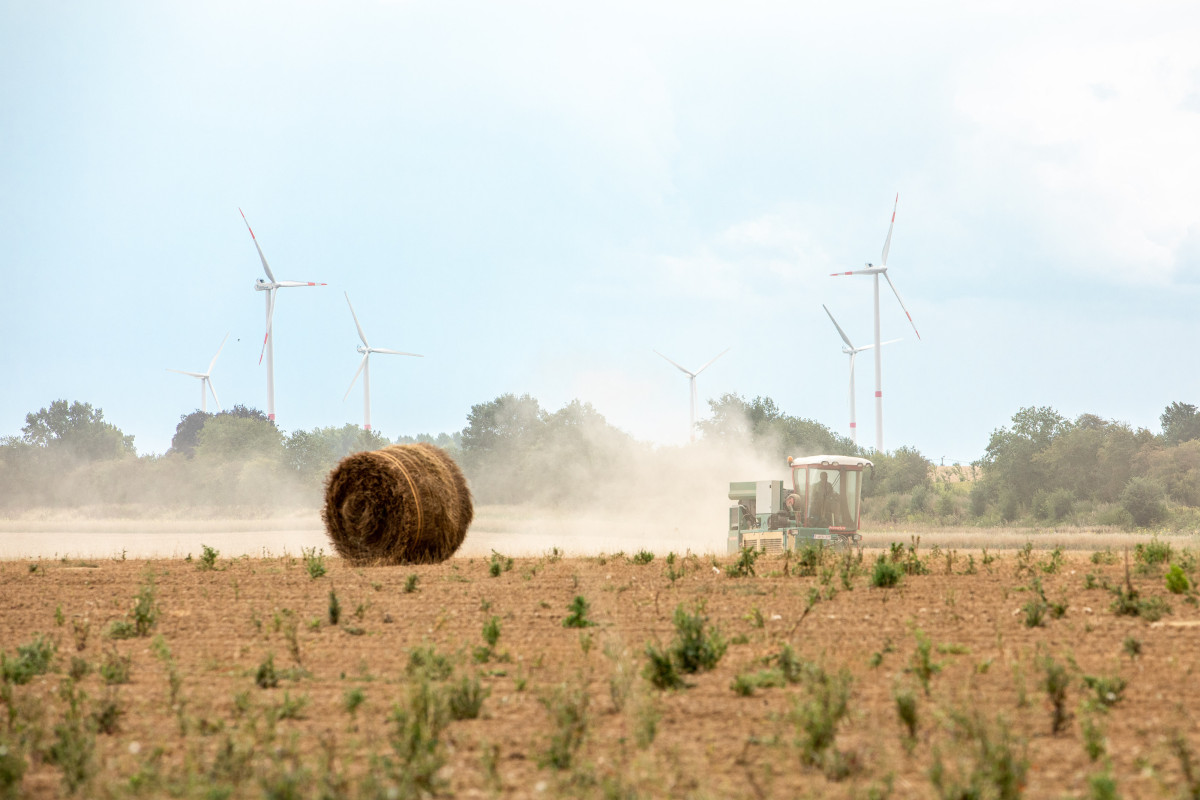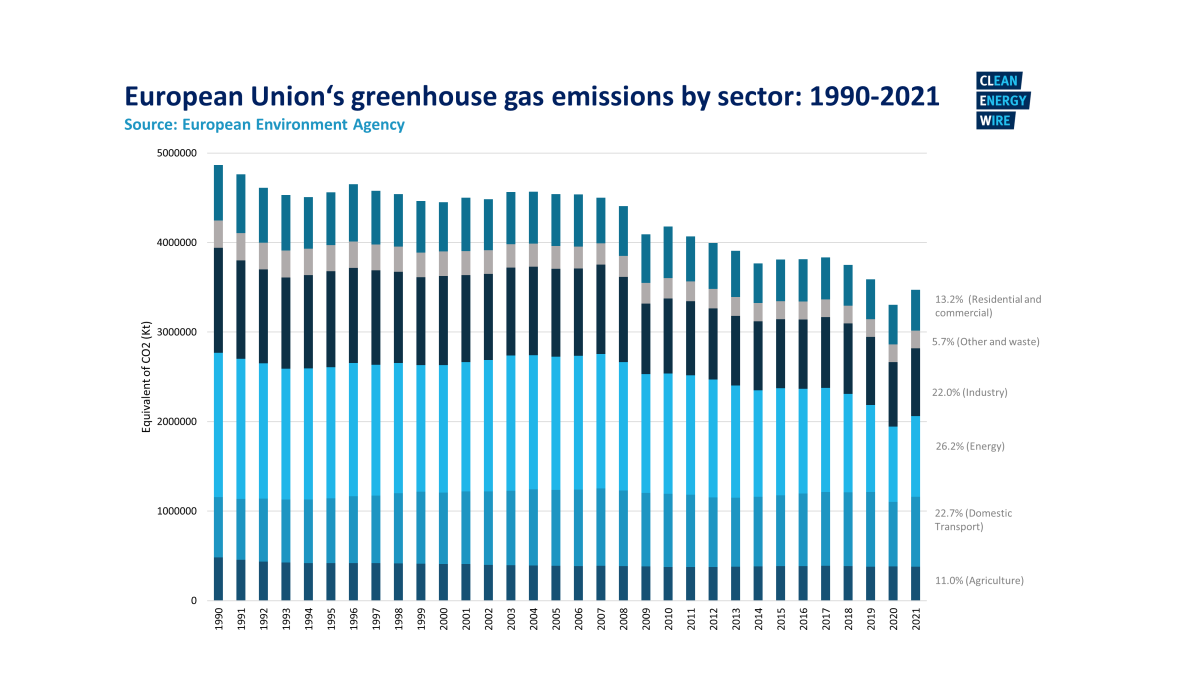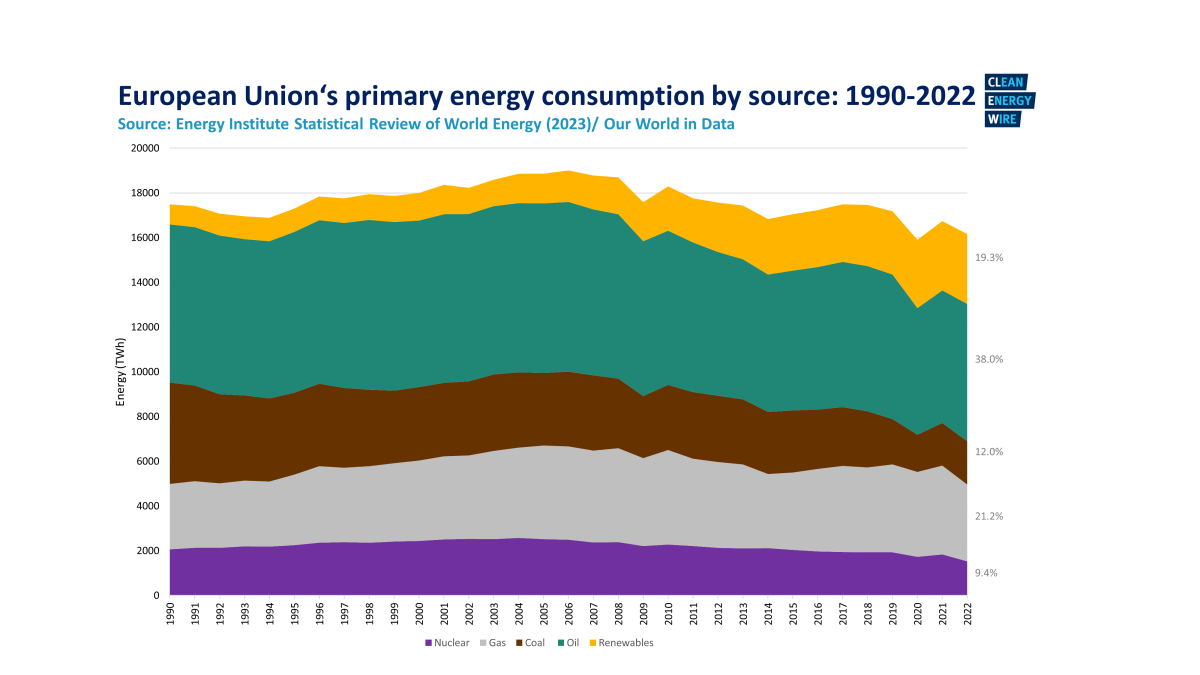CLEW Guide – How the European Union is trying to legislate a path to net-zero
With its “CLEW Guide” series, the Clean Energy Wire newsroom and contributors from across Europe are providing journalists with a bird's-eye view of the climate-friendly transition from key countries and the bloc as a whole. This regularly updated guide provides an overview of how far the EU has come in its transition towards climate neutrality by 2050.
You can also sign up to the weekly newsletter here to receive our "Dispatch from..." – weekly updates from Germany, France, Italy, Croatia, Poland and the EU on the need-to-know about the continent’s move to climate neutrality.
With contributions by Claire Stam, Emanuela Barbiroglio, and Dave Keating.
Content:
Key background
- The EU aims to be ‘climate neutral’ by 2050 and has enshrined that target into its Climate Law. That means it needs to use emissions reductions and removals to ensure it balances out emissions that go into the atmosphere by mid-century;
- The EU also included a 2030 target to reduce net emissions by 55 percent, based on 1990 levels, in its Climate Law. That could increase to 57 percent if the European Union meets its goal to capture 310 million tons CO2 equivalent in nature by 2030;
- Discussions are ongoing on a second interim target for EU emissions reductions by 2040. This will set the stage for the EU’s post-2030 climate and energy policy and give a signal to companies about the emissions cuts needed in the next decade. In July 2025, the European Commission proposed a target of 90 percent, based on recommendations from its Scientific Advisory Board. However, it also included additional flexibilities that the board did not agree with;
- The EU agreed on its 2035 emissions reduction target, required under the Paris Agreement, just days ahead of COP30 on 5 November, having missed two deadlines for submitting this. It aims to cut net emissions by 66.25-72.5 % below 1990 levels by 2035.
- A calculation of EU countries’ energy and climate plans (NECPs) shows that the EU is on track to achieve a 54 percent emissions reduction by the end of this decade, meaning it will fall just short of its 2030 target if all the measures are fully and successfully implemented;
- Climate regulation is a shared competence between the EU and its member countries, meaning that Brussels – which refers to the EU as most of its institutions are based there – sets binding targets to meet common objectives. National governments can set their own legally-binding targets in areas where the EU has not decided to exercise its powers, or that are more ambitious than the EU’s goals. The legislative process usually starts with a proposal by the European Commission, which is then amended and negotiated by the European Parliament and member state representatives in the Council;
- A landmark set of policies, rules and targets packaged under the ‘European Green Deal’ aimed to align the EU with its climate goals, while preserving economic growth and social cohesion. The majority of this has become EU law and now needs to be implemented by member states;
- EU surveys show that a vast majority of EU citizens see climate change as a major threat, think the EU and national governments should act, and believe efforts should be accelerated, not curtailed. However, the importance of climate change to voters dropped in the 2024 EU election compared to the 2019 election;
- At the international level, the EU is a significant power broker in climate diplomacy and financing. In 2023, the EU and its 27 member states mobilised 28.6 billion euros in climate finance from public sources. Its role has become more important following the United States’ departure from the Paris Agreement. However, the EU has also missed a significant deadline to update its climate ambition for 2035 twice.
Major transition stories
- Security, competitiveness, and cost-of-living concerns are putting pressure on the EU and its member states, creating budget constraints, diverting attention from green initiatives, and in some cases, being cited as reasons to slow down the green transition. However, in many cases, green policies can mitigate the impact of these trends, for example, by replacing imported fossil fuels with renewables;
- By 2029, the European Commission aims to reduce the administrative burden for businesses by 25 percent, and for SMEs by 35 percent. This has already led to major overhauls of existing legislation, such as sustainability reporting rules, raising concerns about the EU backsliding amid pressure from business and both EU and non-EU governments;
- The EU wants to be a leader in clean technology, but this is yet to be seen as the EU faces stiff competition, particularly from China. Whether Brussels can rely on its regulatory clout and the strength of its single market against the financial might of its rivals will be an important story. The Clean Industrial Deal (CID), unveiled in February 2025, aims to mobilise over 100 billion euros to support EU-made clean manufacturing. The European Commission is expected to follow this with an Industrial Accelerator Act and a European Grid Package on 10 December
- To reach the EU’s climate and energy targets, it is essential that all 27 member states implement the agreed legislation. It is also key that all regions are included in the transition. Programmes like the Just Transition Fund and Cohesion Fund, aim to ensure this, but could see changes in the next seven-year budget period from 2028-2034;
- The European Commission tabled its plan for the next seven-year budget in July 2025, earmarking 35 percent for climate and environment measures. This will now be subject to negotiations;
- The 2024 EU election saw a rise in the number of far-right politicians in the European Parliament, along with a decline in support for green and left-wing parties. This has led to concerns about the Parliament’s ability to form ambitious negotiating positions, and whether the so-called “von der Leyen” coalition that supported much of the Green Deal will hold up. The new 2024-2028 term also means new people in charge at the European Commission, including centre-left Spaniard Teresa Ribera as the vice president in charge of energy and climate issues.
Energy
- The energy sector is responsible for around 25 percent of the EU’s greenhouse gas emissions, making it one of the bloc’s most polluting sectors. However, it was also responsible for most emissions reductions in 2023, with a 9 percent decline on the previous year. The electricity sector has led this decline;
- The EU needs to reach at least 42.5 percent of renewable energy in its energy mix by 2030. It also has technology-specific goals. For example, at least 42 percent of hydrogen used in industrial processes, like steel smelting, should be sourced from clean power in 2030, rising to 60 percent by 2035;
- In 2023, renewable energy sources represented 24.5 percent of the EU’s final energy use – an estimated one percentage point increase from 2022. Non-renewable energy sources saw a reduction of three percent, mainly linked to a drop in coal use. The share of renewables in each EU country differs greatly. Sweden and Finland lead, while Belgium, Malta and Ireland have the lowest shares;
- In 2024, renewables produced 47 percent of the EU’s electricity, up from 34 percent in 2019, largely due to growth in solar and wind energy. That year also saw solar generation surpass coal for the first time, and the fifth year in a row where electricity production from gas declined. Nuclear energy remains the largest power producer;
- High energy prices add to concerns about competitiveness and cost-of-living in the EU. The shift from volatile fossil fuel markets to clean energy sources is seen as a way to reduce bills, but also requires investments in grids, storage and other flexibility measures, as well as support for clean technologies. Other ways to cut prices include revising taxes. However, an attempt to reform EU tax law to address price disparities between electricity and gas has been stuck since 2021;
- The EU used to be heavily dependent on fossil fuel imports from Russia, but since the invasion of Ukraine, the bloc has been working to reduce its dependence on Russian energy imports. The EU has reached a provisional agreement to ban all imports of Russian gas by 1 November 2027 at the latest. The European Commission has also tabled plans to ditch Russian oil and gas by the beginning of 2028. Imports of Russian coal and seaborne oil are already banned. The EU also aims to stop importing Russian nuclear fuel, but does not have a specific date for this;
- Under a trade agreement made in July 2025, the European Union said it will buy 750 billion US dollars’ worth of energy from the United States up to 2028. However, critics have questioned how this is possible.
Next big thing:
A major implementation effort is required for the EU to reach its goal of 42.5 percent of renewables in its energy mix by 2030. Alongside this, the modernisation and build-out of Europe’s grid system is critical to avoid curtailing renewables and to make use of renewable production during times of low demand by storing it. Investments in Europe's distribution grids need to double to 67 billion euros per year by 2050, according to the industry. The European Commission is due to propose a European Grid Package in December and an electrification action plan early next year.
Industry
- Industry accounts for just over 20 percent of total EU emissions;
- The EU’s emission trading system (ETS) is the bloc’s main decarbonisation tool, functioning as a “cap and trade” system where companies in certain sectors must purchase emissions permits that gradually reduce in number over time. In 2023, these permits were trading around 100 euros per tonne of carbon emissions but dropped to close to 50 euros in February 2024. As of October 2025, they are sitting around 77 euros;
- Industrial sectors covered by the EU’s ETS almost halved their emissions in 2023 compared to 2005. Industry can decarbonise via electrification or by switching to new feedstocks, like hydrogen made using clean energy;
- ETS reforms, adopted in 2023, include tightening the cap on permits to increase emissions reductions, bringing maritime transport emissions into the scope from 2024, and launching a second carbon pricing scheme for buildings and road transport from 2027. This may now be delayed until 2028. The European Commission will soon present proposals to amend this scheme, including to ensure more price predictability;
- ‘Free permits to pollute’ previously allocated to companies exposed to the price on carbon emissions will gradually be phased out between 2026 and 2034. To replace these and prevent carbon leakage – where businesses relocate to somewhere cheaper to pollute – the EU will impose a carbon border tax, known as the carbon border adjustment mechanism (CBAM). This will start by covering cement, iron and steel, aluminium, fertilisers, electricity and hydrogen. In October 2023, the EU launched CBAM’s transition phase and then agreed to exempt companies under a certain amount of emissions per year in 2025 as part of a simplification process. CBAM is set to formally come into effect on 1 January 2026;
- The 2024 Draghi Report on European competitiveness emphasised the need for more work to strengthen Europe’s industry. In response, the European Commission tabled the Clean Industrial Deal and is expected to table legislation covering batteries, grids, and measures to bolster industry in November;
- Carbon capture, utilisation and storage (CCUS) is touted as a potential solution for hard-to-decarbonise industrial sectors, such as cement. The European Commission presented an industrial carbon management plan in February 2024 to explore how to develop the sector. It also included an obligation on oil and gas producers to make available 50 million tonnes of permanent CO2 storage a year by 2030 in its Net-Zero Industry Act. It will table a law on CO2 markets and transportation infrastructure in Q3 of 2026, according to the European Commission work programme.
Next big thing:
The European Commission is expected to present a series of proposals to implement the Clean Industrial Deal on 10 December, including the Industrial Accelerator Act. However, there are concerns around the Commission dropping the word “decarbonisation” from the accelerator act’s name. It is also worth keeping an eye on whether permanent carbon removals are included in the ETS in the future.
Buildings
- Buildings are responsible for around 40 percent of the EU’s energy consumption, and around 13 percent of emissions, mostly due to heating and cooling, as well as lighting;
- Around 85 percent of today’s buildings will still be standing in 2050. This means it is critical to address their emissions, and renovate them to improve their energy efficiency;
- Badly insulated buildings are the root cause of the sector’s high energy and climate impact, but EU annual renovation rates barely scrape above 1 percent. The EU’s main strategy, the Renovation Wave, aims to at least double that by 2030;
- Two main pieces of legislation govern the EU buildings sector: the Energy Performance of Buildings Directive (EPBD) and the Energy Efficiency Directive (EED). According to the updated EED, the EU must reach total combined energy savings of 11.7 percent by 2030, Unlike previous iterations, that target is mandatory. Under the new EPBD, the worst-performing 16 percent of buildings need to be renovated by 2030 and fossil fuel boilers will gradually be phased out;
- Under the EU’s plan to ditch Russian energy, it aimed to double the number of individual heat pumps, adding 10 million by 2027;
- Buildings will also be subject to emissions trading for the first time as part of ETS II, a separate carbon market due to launch in 2027. However, this is likely to be delayed until 2028 as both the European Parliament and EU countries support this. The decision to delay it will be made as part of talks on the EU’s 2040 climate target.
- A new instrument, known as the Social Climate Fund, will help cushion the blow on vulnerable households, providing a maximum of 65 billion euros between 2026 and 2032. However, critics warn this will not be enough to drive change in the targeted sectors.
Next big thing:
The likely delay of ETS II has raised concerns from environmental groups and clean tech companies, as it could reduce the incentive to move away from fossil fuels and impact the money available to support vulnerable households in the energy transition. Denmark has said it will lose around €500 million in revenues from the system.
The implementation of energy efficiency, buildings and renewable energy laws will be critical to decarbonising Europe’s building stock. Alongside this, the upcoming Citizens Energy Package, Heating and Cooling Strategy, and Electrification Action Plan are likely to be highly relevant to the sector.
Mobility
- Domestic transport (excluding international aviation and shipping) is the EU’s most carbon-intensive sector, contributing over 25 percent of its greenhouse gases. Unlike other sectors, its emissions are not trending downwards;
- Road transport makes up 73 percent of transport emissions;
- The amount of renewable energy in road and rail transport increased from less than 2 percent in 2005 to over 10 percent in 2023. EU countries have the choice to reach a 29 percent share of renewable energy in transport by 2030 or slash the sector’s greenhouse gas intensity by at least 14.5 percent;
- EU legislation governing engine standards, CO2 reduction targets, charging infrastructure rollout and zero-carbon fuel deployment aims to address the sector’s climate impact. However, the 2025 emissions reduction target for cars has been extended to give companies more flexibility and, while the 2035 ban on sales of new combustion engine cars remains in place, it is under political pressure;
- In 2027, a separate carbon market for road transport and buildings will be established to put a price on their emissions (see buildings section above). Groups are also calling for member states to use the revenues to support schemes like social leasing of electric vehicles to reduce the impact;
- The EU is trying to support the move to electric vehicles with charging infrastructure rollout. Under new rules, there will need to be at least 400 kW every 60 km on the core road network by the end of 2025, while for heavy-duty vehicles, a charging hub must be available every 60 km on the core network by the end of 2030. Grid resilience and flexibility will also be key for this;
- Since 2024, shipping has been covered by the EU’s original emissions trading system (ETS). A separate law also looks into boosting the uptake of low-carbon fuels in the sector.
Next big thing:
The EU was expected to propose laws and initiatives to support the transport sector on 10 December, including a revision of CO2 emission rules for cars and vans, as well as measures to support electric vehicles, including a Battery Booster Strategy and a law to help green corporate car fleets. However, there are reports that this could be delayed by several weeks.
There are ongoing concerns about the EU automotive sector’s competitiveness, particularly due to Chinese electric vehicles and US trade pressures. In January 2025, the Commission launched a Strategic Dialogue on the Future of the Automotive Industry to address this.
Agriculture & land use
- Agricultural emissions account for about 12 percent of the EU’s total greenhouse gases, and are mostly from methane and nitrogen. Non-CO2 emissions fell by only 5 percent between 2005 and 2022 and agriculture emissions are projected to drop by 7 percent by 2030 with the implementation of additional, currently planned measures;
- Agriculture emissions are governed by the Effort Sharing Regulation (ESR), which aims to reduce emissions in covered sectors by 40 percent by 2030 compared to 2005. Given that little progress is expected in agriculture, bigger cuts will have to be made in other sectors such as waste, buildings and road transport;
- Agriculture is also subject to the Land Use, Land Use Change and Forestry Regulation (LULUCF), which governs how this contributes to climate goals. By 2030, EU nature should store 310 million tons of CO2 equivalent. However, Europe’s land sink – the amount of carbon stored in nature – is decreasing due to a range of pressures;
- The latest European Environmental Agency’s state of the environment report shows significant progress in reducing greenhouse gas emissions and air pollution, but warns the overall state of Europe’s environment is not good and that nature faces degradation, overexploitation and biodiversity loss;
- The EU has agreed several laws to reduce its impact on nature, including the Nature Restoration Law and the EU Deforestation Regulation. However, the implementation of the ban on deforestation in supply chains was delayed, and the Nature Restoration Law was heavily watered down during negotiations;
- In July 2025, the European Commission proposed its plan for the post-2027 Common Agricultural Policy (CAP) – the main legislation covering agriculture and support for farmers. According to the Commission, the proposal is simpler, more targeted and future-oriented and will provide a fair income for farmers, safe and affordable food for consumers, and protection for the environment;
- The Green Claims Directive that aims to provide consumers with more information about the products they consume is currently stuck in negotiations, following the European Commission’s threat to scrap it. This has ramifications on other laws, such as the Carbon Removals Certification Framework, which will set out methodologies for different types of removals but was relying on it for use cases.
- The European Commission tabled its Bioeconomy Strategy on 27 November. The idea is to use biomass from nature to replace fossil fuels in the European economy. This has the potential to help cut Europe’s emissions and reduce its reliance on imported fossil fuels, but needs to be done in a way that does not impact Europe’s nature, which is already losing its ability to capture carbon.
Next big thing:
Negotiations on the new Common Agricultural Policy and how much money will support it will be key. EU countries are also beginning to pushback on carbon sink targets, in part blaming climate impacts. It is worth following how this impacts the EU’s 2030 and 2040 climate goals.
Finance
- Under the Paris Agreement, signatories agreed to align finance flows with a pathway consistent with lowering greenhouse gas emissions and climate-resilient development;
- The European Union has several laws to green finance. This includes the Corporate Sustainability Reporting Directive (CSRD) and Corporate Sustainability Due Diligence Directive (CSDDD). However, there are concerns from NGOs and green business coalitions that these are being watered down in the European Commission’s current ‘simplification’ drive, with the scope and requirements being cut;
- To create a more harmonised understanding of what investments count as ‘green’, the European Commission designed the Sustainable Finance Taxonomy. However, this also became politicised during debates as to whether to include gas and nuclear;
- The European Union and its member states are the biggest contributors to international climate finance and are important players in initiatives like Just Energy Transition Partnerships.
Next big thing:
EU countries and the European Parliament are currently in talks to agree on the simplification of CSRD and CSDDD. Both want to reduce the number of companies covered in the scope. However, the European Parliament also wants to scrap plans that would align companies’ work with the Paris Agreement. Meanwhile, EU countries want to move away from the risk-based approach that proponents think is key to reducing harms across the supply chain.
Find an interviewee
Find an interviewee from across Europe in the CLEW expert database. The list includes researchers, politicians, government agencies, NGOs and businesses with expertise in various areas of the transition to climate neutrality from across Europe.
Get in touch
As a Berlin-based energy and climate news service, we at CLEW have an almost 10-year track record of supporting high-quality journalism on Germany’s energy transition and Europe’s move to climate neutrality. For support on your next story, get in touch with our team of journalists.
Tipps and tricks
-
Useful links on EU climate and energy:
- CLEW’s Easy Guide to Germany’s transition with background information and links to key energy and climate data.




